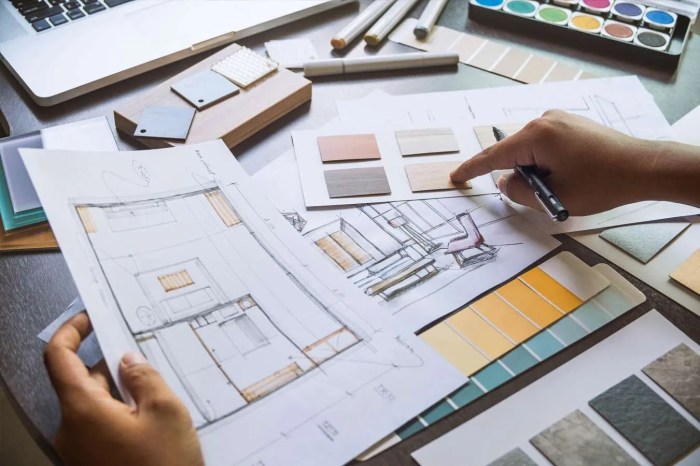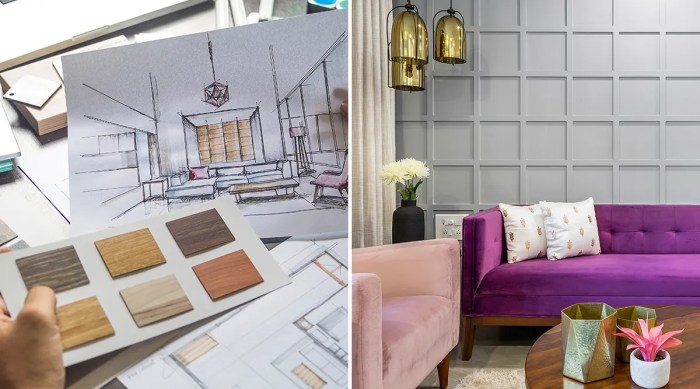Embark on a journey where the realms of architecture and interior design converge, shaping environments and experiences with precision and flair. This introductory passage sets the stage for a deep dive into the world of architects and interior designers, offering a glimpse into the intricate balance of creativity and functionality that defines their work.
Delve into the nuances of building design, the art of enhancing indoor spaces, and the collaborative efforts that bring architectural visions to life.
Overview of an Architect and Interior Designer
Architects play a crucial role in designing buildings and structures, focusing on the overall look, functionality, and safety of the space. They are responsible for creating architectural plans, overseeing construction, and ensuring that the final structure meets the client's needs and adheres to building codes and regulations.
On the other hand, interior designers specialize in enhancing indoor spaces, focusing on the aesthetics, functionality, and overall feel of a room. They work closely with clients to understand their preferences and create designs that optimize the use of space, color schemes, furniture, and decor elements.
Roles and Responsibilities of an Architect:
- Creating architectural plans and designs for buildings and structures.
- Collaborating with clients, engineers, and construction teams to ensure projects are executed accurately.
- Ensuring that buildings meet safety standards and regulations.
Duties and Tasks of an Interior Designer:
- Consulting with clients to determine their needs, preferences, and budget constraints.
- Creating design concepts, selecting furniture, color schemes, and decor elements.
- Coordinating with architects and contractors to implement design plans.
Differentiation between an Architect and an Interior Designer:
While architects focus on the overall structure and external appearance of a building, interior designers concentrate on the aesthetics and functionality of indoor spaces. Architects are involved in the planning and construction of the entire building, whereas interior designers work on enhancing the interior environment to create a cohesive and visually appealing space.
Education and Training

Becoming an architect or interior designer requires a specific educational path and training. Let's delve into the typical routes and qualifications for each profession.
Architects
To become an architect, individuals typically need to complete a professional degree in architecture from an accredited program. This can be a Bachelor of Architecture (B.Arch) or a Master of Architecture (M.Arch) degree. After completing their degree, aspiring architects must also gain practical experience through internships or apprenticeships.
In addition to the educational requirements, architects must pass the Architect Registration Examination (ARE) to become licensed. Each state has its own specific requirements for licensure, so architects must also fulfill those criteria to practice legally.
Interior Designers
Interior designers also require a specific educational background to enter the field. While a formal degree is not always mandatory, most employers prefer candidates with a Bachelor's degree in interior design or a related field. Programs accredited by the Council for Interior Design Accreditation (CIDA) are highly regarded in the industry.Certification is not required to work as an interior designer, but many professionals choose to become certified through organizations like the National Council for Interior Design Qualification (NCIDQ).
This certification demonstrates a designer's competence and knowledge in the field.
Training Comparison
While both architects and interior designers need formal education, the paths to licensure or certification differ between the two professions. Architects must complete a specific degree, gain practical experience, and pass a licensing exam, while interior designers can work without formal certification but may choose to become certified to enhance their credentials.
Skills and Competencies

Architects and interior designers require a unique set of skills and competencies to excel in their respective fields. These professionals must possess a combination of technical knowledge, creative abilities, and interpersonal skills to successfully bring their visions to life.
Essential Skills for Architects:
- Technical Proficiency: Architects need to have a strong understanding of architectural principles, building codes, and construction methods.
- Design Skills: The ability to conceptualize and create innovative designs that are both functional and aesthetically pleasing is crucial for architects.
- Problem-Solving Skills: Architects must be able to think critically and find creative solutions to complex design challenges.
- Communication Skills: Effective communication with clients, contractors, and team members is essential for architects to ensure that projects are executed according to plan.
- Project Management: Architects need to be skilled in project management to oversee the entire design and construction process from start to finish.
Key Competencies for Interior Designers:
- Space Planning: Interior designers must have a keen eye for spatial arrangements and be able to optimize the functionality of a space.
- Color Theory and Coordination: Understanding color psychology and how to harmonize different colors is essential for creating cohesive design schemes.
- Material Knowledge: Interior designers need to have a good understanding of materials, fabrics, and finishes to select the right elements for each project.
- Client Management: Building strong relationships with clients and understanding their needs and preferences is key for interior designers to deliver satisfactory results.
- Attention to Detail: Interior designers must pay close attention to details to ensure that every aspect of a design is carefully considered and executed.
Creativity in Architecture and Interior Design:
Creativity is at the core of both architecture and interior design. Architects and interior designers use their creativity to envision and develop unique design concepts that reflect their clients' personalities and meet their functional requirements. Whether it's designing a sustainable building or creating a cozy living space, creativity plays a crucial role in transforming ideas into tangible spaces that inspire and delight.
Project Collaboration
Collaboration between architects and interior designers is crucial in creating cohesive and functional spaces that meet the needs and vision of the clients. By working together, they can combine their expertise to ensure that both the structural and aesthetic aspects of a project are seamlessly integrated.
Successful Projects Collaboration
- In the renovation of a luxury hotel, the architect focused on redesigning the layout for better flow and structural stability, while the interior designer selected furnishings, finishes, and decor to enhance the overall ambiance.
- For a modern office building, the architect designed the exterior facades and layout of the workspace, while the interior designer chose color schemes, lighting, and furniture to create a productive and inviting environment.
Communication and Coordination
During a project, architects and interior designers must maintain open communication to ensure that the design elements align with the overall vision. Regular meetings, site visits, and digital collaboration tools are often used to share ideas, provide feedback, and address any challenges that may arise.
Design Process

The design process is a crucial aspect of the work done by architects and interior designers. It involves a series of steps that are followed from the initial concept to the final completion of a project. Let's delve into the specific steps involved in the design process for both architects and interior designers.
Architects Design Process
- Concept Development: Architects start by understanding the client's needs and requirements, creating initial sketches, and developing a concept for the project.
- Schematic Design: This stage involves further refining the design, creating drawings, and exploring different options for the project.
- Design Development: Architects work on detailed drawings, specifications, and material selections to finalize the design.
- Construction Documentation: This step involves creating detailed construction drawings that will be used by contractors to build the project.
- Construction Administration: Architects oversee the construction process to ensure that the design is implemented correctly and meets the client's expectations.
- Project Completion: Once construction is finished, architects inspect the final project to ensure it meets the design intent and client requirements.
Interior Designers Design Process
- Initial Consultation: Interior designers meet with clients to understand their needs, style preferences, and budget for the project.
- Space Planning: Designers create layouts and floor plans to optimize the use of space and fulfill the client's requirements.
- Design Concept: Based on the client's preferences, interior designers develop a design concept that includes color schemes, furniture selections, and decorative elements.
- Material Selection: Designers choose materials, finishes, and fabrics that align with the design concept and meet the client's expectations.
- Implementation: Interior designers work closely with contractors and suppliers to bring the design concept to life, overseeing the execution of the project.
- Final Presentation: Once the project is completed, interior designers present the final design to the client for approval, making any necessary adjustments.
Client Preferences Integration
Architects and interior designers play a critical role in incorporating client preferences into their designs. They achieve this by conducting thorough discussions, presenting various design options, and actively listening to feedback from clients throughout the design process. By maintaining open communication and collaboration with clients, architects and interior designers ensure that the final design reflects the client's vision and meets their expectations.
Trends and Innovations
Architecture and interior design are constantly evolving fields that are heavily influenced by trends and innovations. Let's explore some of the current trends shaping the work of architects and interior designers today.
Sustainable Design and Technology Integration
One of the most prominent trends in architecture and interior design is the focus on sustainability. Architects are increasingly incorporating eco-friendly materials and energy-efficient systems into their designs to reduce the environmental impact of buildings. Interior designers are also embracing sustainability by using repurposed or recycled materials and designing spaces that promote wellness and mindfulness.
Biophilic Design and Nature Integration
Another trend gaining popularity is biophilic design, which emphasizes the connection between humans and nature in the built environment. Architects and interior designers are incorporating natural elements such as plants, natural light, and organic materials to create spaces that enhance well-being and productivity.
This approach not only improves the aesthetics of a space but also contributes to the health and happiness of its occupants.
Innovative Materials and Construction Techniques
Advancements in technology and materials have opened up new possibilities for architects and interior designers to create innovative and unique spaces. From 3D printing and modular construction to smart materials and interactive design elements, professionals in these fields are pushing boundaries and experimenting with cutting-edge techniques to bring their visions to life.
Conclusion
As we draw the curtain on our exploration of architects and interior designers, we reflect on the dynamic interplay between form and function, creativity and practicality. This captivating summary encapsulates the essence of a profession that shapes the spaces we inhabit, leaving an indelible mark on our lives.
Frequently Asked Questions
What are the main responsibilities of an architect?
An architect is primarily responsible for designing buildings and structures, considering functionality, aesthetics, and safety regulations.
What qualifications are required to become an interior designer?
Interior designers typically need a bachelor's degree in interior design or a related field, along with relevant certifications and licenses.
How do architects and interior designers incorporate client preferences into their designs?
Both professionals engage with clients to understand their needs, preferences, and style preferences, integrating them into the design process to create personalized spaces.















